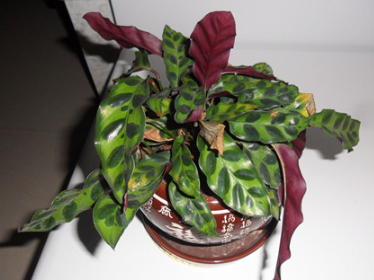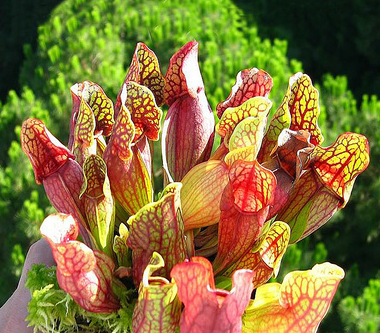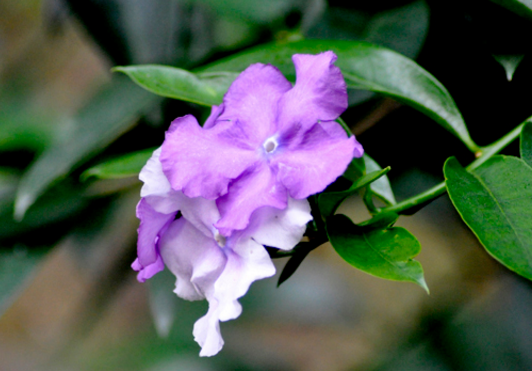What if the leaves of cat's eye bamboo taro turn yellow? do they bloom?
Cat's eye taro can be used as landscaping, planted in the courtyard or park for viewing. It is also a very valuable plant. Do you know it? if you don't understand it, take a look at the beauty of Cat's Eye Taro.

What if the leaves of cat's eye bamboo taro turn yellow?
Causes and treatment of yellowing of leaves of Amorphophallus maoyanensis
1. Improper lighting
Cat's eye bamboo taro likes shade and the light is too strong, which may cause plant leaves to burn, yellow spots appear on the leaf surface, and cause cat's eye bamboo taro leaves to wither and turn yellow. in this case, cat's eye bamboo taro should be moved to the indoor shade.
If the light is too little, the leaves can not get enough light, it will not be able to form chlorophyll, causing the leaves to turn yellow and fall off, so it is necessary to replenish the sun properly.
2. Improper watering
The cat's eye taro leaves are larger and the water evaporates quickly. if the old leaves begin to scorch and fall off, the tips and edges of the leaves are withered and bent, it means that the cat's eye taro is watered too little, so it is necessary to water more and spray more to keep the basin soil and the surrounding air moist.
When the young leaves of cat's eye taro are dull, and the branches and shoots are shrunk and small yellow and green, it may be caused by too much watering. At this time, put the cat's eye taro in a ventilated place, dry the soil mass, reduce the watering frequency, and do less watering and wetting.
3. Improper fertilization
In the process of planting, if the tip of the new leaf is yellowish brown and the old leaf is scorched yellow, it is because of the high concentration of fertilization that the plant turns yellow. Fertilizer should be stopped immediately. If the situation is serious, the pot soil should be replaced and the residual fertilizer on the roots and leaves of the cat's eye taro should be cleaned.
If there is little or no fertilization at ordinary times, the yellowing of leaves may also be a lack of nutrients, so you should change the basin in time to apply thin fertilizer frequently.
Does cat's eye taro blossom?
Although cat's eye taro is a foliage plant, it can also blossom with elegant and fragrant flowers. Next, let's take a look at the flowering cat's-eye taro.
Don't be deceived by the appearance of Cat's Eye Taro, taking it for granted that it is just a foliage plant. Cat's eye taro can blossom, but flowering is relatively rare. It is possible to blossom only in a good environment with suitable temperature and humidity and careful maintenance.
Because of the low temperature and dryness in the north, it is not easy for the cat's eye taro to blossom in this climate, while the humid and warm environment in the south is relatively easy to promote the flowering of the cat's eye taro.
1. The pattern and color of cat's eye taro.
The flowers of cat's eye taro are pure white and the color is fresh and elegant. Each flower has 3-4 petals of different length.
Cat's eye taro flower aroma is rich, a bit like the taste of gardenia, there is no harm to the human body.
2. Matters needing attention in flowering of cat's eye taro
The ornamental value of cat-eye taro mainly lies in the leaves, and the flowering of cat-eye taro will consume plant nutrients, so in order to avoid the loss of nutrients resulting in the decrease of leaf aesthetics, the buds of cat-eye taro can be properly subtracted.
The floral aroma of cat's eye taro is rich and has no harm to the human body. However, if there are people at home who are allergic to the smell of flowers, you still need to pay attention to it. It is best to put the open cat's eye taro in a ventilated place or outside.
Propagation method of Cat's Eye Amorphophallus
Cat's eye taro is a perennial evergreen herb, mainly foliage, which is usually used to plant indoors to beautify the home environment. Most of the propagation methods of plants are cutting, which is not only simple to operate, but also has a high survival rate. I wonder if the cat's eye taro is the same prevention and control method? What are the points for attention?
Propagation method of Cat's Eye Taro
I. split-plant propagation
1. Ramet time
It is generally chosen when the temperature is about 20 ℃ in late spring and early summer, but it can be carried out throughout the year as long as the temperature and humidity are appropriate.
2. Ramet method
First of all, the mother plant of cat's eye taro was taken out of the basin and the root block with stem, leaf or leaf bud was cut with a sharp knife.
Immediately after the cutting is finished, it is watered in the basin and placed in a cool place, the temperature and humidity are controlled in the early stage, and normal maintenance can be carried out after the new roots grow out.
2. Cutting propagation
1. Cutting time
It can be carried out when the temperature is not lower than 20 ℃.
2. Cutting method
Generally choose the top tender shoot, the cuttage length is about 10-15 cm, according to the size of the leaf, retain its 1/3 or 1/2.
The cuttings can be treated with indoleacetic acid, indolebutyric acid or ABT rooting powder, and the cuttings can take root in about 30-50 days.
After the cuttings are treated, they are inserted into the seedbed with a row spacing of 5 × 10 cm and covered with a film bow shed.
How to raise cat's eye taro
1. Temperature
Cat's eye bamboo taro is native to tropical and subtropical regions and is resistant to high temperature. It is suitable to be in the growth environment of 20-30 ℃. The most suitable growth temperature in winter should be about 16-18 ℃.
2. Lighting
Shade-tolerant plants, sexual preference for semi-shade, should be placed in a bright indoor light. Avoid direct sunlight, exposure, etc., in order to avoid burning leaves. Shading and ventilation should be done well in summer.
3. Watering
In the growth period of cat's eye taro, it is necessary to fully water the soil and keep the soil moist. At the same time, we should also pay attention to avoid causing stagnant water in the soil, so as not to cause rotten roots and even cause plant death. As the leaves of the cat's eye taro are larger and the water evaporates quickly, it is necessary to maintain a high air humidity around it. The leaves can be sprayed frequently to keep the air around the leaves moist, which is beneficial to the growth and extension of the leaves. Once the leaves are found to curl and atrophy, it means that the plant is in a state of lack of water.
4. Fertilizer
Follow the principle of "giving frequently and sparingly". Stop fertilizing during the dormant period in winter and the high temperature in summer.
What if the leaves of cat's eye bamboo taro turn yellow?
1. Improper lighting
Cat's eye bamboo taro likes shade and the light is too strong, which may cause plant leaves to burn, yellow spots appear on the leaf surface, and cause cat's eye bamboo taro leaves to wither and turn yellow. in this case, cat's eye bamboo taro should be moved to the indoor shade.
If the light is too little, the leaves can not get enough light, it will not be able to form chlorophyll, causing the leaves to turn yellow and fall off, so it is necessary to replenish the sun properly.
2. Improper watering
The cat's eye taro leaves are larger and the water evaporates quickly. if the old leaves begin to scorch and fall off, the tips and edges of the leaves are withered and bent, it means that the cat's eye taro is watered too little, so it is necessary to water more and spray more to keep the basin soil and the surrounding air moist.
When the young leaves of cat's eye taro are dull, and the branches and shoots are shrunk and small yellow and green, it is likely to be caused by too much watering. At this time, put the cat's eye taro in a ventilated place, dry the soil mass, reduce the watering frequency, and do less watering and wetting.
3. Improper fertilization
In the process of planting, if the tip of the new leaf is yellowish brown and the old leaf is scorched yellow, it is because of the high concentration of fertilization that the plant turns yellow. Fertilizer should be stopped immediately. If the situation is serious, the pot soil should be replaced and the residual fertilizer on the roots and leaves of the cat's eye taro should be cleaned.
If there is little or no fertilization at ordinary times, the yellowing of leaves may also be a lack of nutrients, so you should change the basin in time to apply thin fertilizer frequently.
Does cat's eye taro blossom?
Don't be deceived by the appearance of Cat's Eye Taro, taking it for granted that it is just a foliage plant. Cat's eye taro can blossom, but flowering is relatively rare. It is possible to blossom only in a good environment with suitable temperature and humidity and careful maintenance.
Because of the low temperature and dryness in the north, it is not easy for the cat's eye taro to blossom in this climate, while the humid and warm environment in the south is relatively easy to promote the flowering of the cat's eye taro.
This is the end of the breeding methods and maintenance skills of cat's eye taro. I hope it will be helpful to everyone. Although many plants usually propagate by cutting, if it is for cat's eye taro, the editor still suggests that we adopt the method of split propagation, because the survival rate of cuttings is far lower than that of individual plants.
Seven misunderstandings about why potted plants frequently have yellow leaves and flowers
Flower Bonsai Network Guide: today, Flower Bonsai Network will introduce to you 7 misunderstandings about why potted plants frequently have yellow leaves and flowers. If you like flowers, let's have a look.
If you are the kind of friend who raises all kinds of potted plants with yellow leaves, you must reflect on yourself and exchange your experience of growing flowers with experienced ones to see where mistakes have been made and correcting them in time can still save a lot of plants.
1. Frequent watering of cheap hands
The potted soil of plants in some friends' homes is always wet. except for plants like copper grass and bowl lotus, which like to soak and grow in water, other green plants have such an environment that the leaves are yellow and the roots rot over time.
The initial symptom is that the young leaves at the top turn yellow and appear water-stained lines, which is the stagnant water of the root system, which needs to be controlled to dry the basin soil in time.
2. Often forget the water supply
Like the following pot of cat's eye taro, I like my warm and humid plant very much. If I often forget to water it, its leaves will become dry and yellow, the leaf edges will turn brown, and the leaves are not only dry, but also a little bit dry, so I often forget to water them.
In addition to watering, but also pay attention to each watering thoroughly, until there are water droplets dripping from the bottom of the basin, basin soil dry thoroughly is a very common skill.
3. The importance of rational fertilization.
If plants are not fertilized properly, plants will not grow well. If they often forget to apply fertilizer, their leaves will easily appear bright yellow. The newly grown leaves are very tender, and it is basically difficult for them to grow strong, and plants will not blossom.
At this time, we need to replenish the fertility, the appropriate fertility can make the branches and leaves of the plant grow thicker and stronger, only with enough soil, the plant can flourish and promote flowering.
4. What if there is too much fertilizer?
If you fertilize too much, water should be used to dilute the fertility, otherwise it will also burn the plant roots.
What are the symptoms of applying too much fertilizer? Such as the following dripping Guanyin, when the fertility is too large, the leaves appear uneven, the new leaves are particularly thick, and the old leaves suddenly turn yellow.
5. What about the alkaline soil?
Most flowering plants like slightly acidic soil, but if the soil is often watered, it is easy to be alkaline, and the plant growth state will change, as shown in the yellow leaves, and the leaves are easy to turn yellow.
What is most needed at this time is to improve the pH of the soil, you can go to the florist to buy some ferrous sulfate diluted with water, a more effective method.
7. Proper lighting
Plants need suitable light to grow better. Proper photosynthesis can not only increase the resistance of plants, but also promote flowering.
Such as the crab claw orchid below, it needs about 3 to 8 hours of scattered light every day, it is easier to give birth to buds, if there is no light, there are buds, it will soon fall out.
Before the conservation of plants, of course, to understand its needs for sunlight, do not understand can ask flower friends, after the maintenance will become very simple, if only know how to grow flowers, do not know how to communicate, plants will be very difficult to grow good-looking.
- Prev

How to raise insectivorous plants
Plants, many think this is vegetarian, in fact, not so, there are some plants are to eat meat, to see what insectivorous plants? How to raise insectivorous plants: Sagittarius Sagittarius is different from other insectivorous plants. It not only eats small flying insects, but also eats small animals as large as mice. and
- Next

What is the effect of the two-color jasmine cutting method?
There is a pot of two-color jasmine at home, it is a bit lonely! The second child has been released, put a few pots of flowers and plants on your balcony, accompany each other, flowers will also grow healthily. You want to see a strange landscape with two colors and one flower. The cutting method of two-color jasmine The cutting soil of two-color jasmine
Related
- Fuxing push coffee new agricultural production and marketing class: lack of small-scale processing plants
- Jujube rice field leisure farm deep ploughing Yilan for five years to create a space for organic food and play
- Nongyu Farm-A trial of organic papaya for brave women with advanced technology
- Four points for attention in the prevention and control of diseases and insect pests of edible fungi
- How to add nutrient solution to Edible Fungi
- Is there any good way to control edible fungus mites?
- Open Inoculation Technology of Edible Fungi
- Is there any clever way to use fertilizer for edible fungus in winter?
- What agents are used to kill the pathogens of edible fungi in the mushroom shed?
- Rapid drying of Edible Fungi

